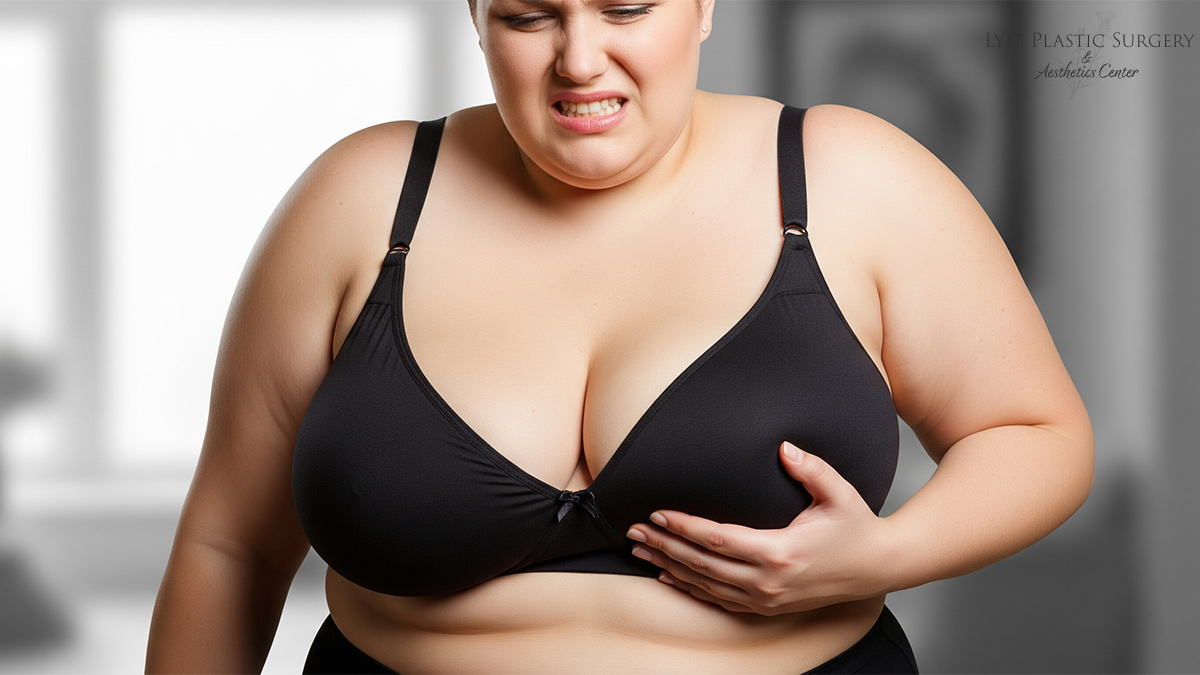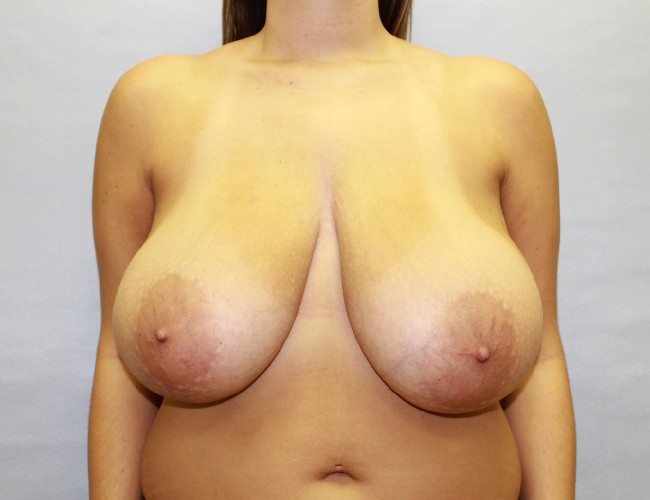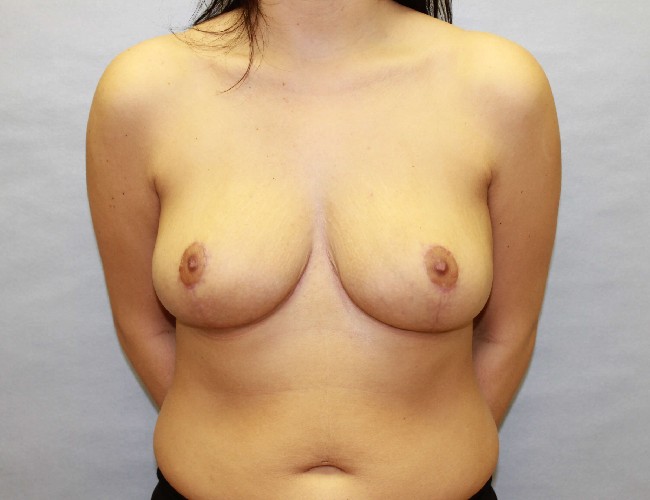
As a plastic surgeon in Raleigh, NC, Dr. Glenn Lyle has met countless women who tell him the same thing: “I just thought I had to live with it.” For many, overly large breasts are more than just a cosmetic concern – they are a daily burden.
Macromastia is the medical term for this condition. It causes significant physical discomfort and emotional distress, from chronic back and neck pain to trouble exercising and social discomfort. At his practice in Raleigh, Dr. Lyle helps women of all ages find relief and rediscover confidence through safe, life-changing breast reduction surgery.
Macromastia can also lead to sleep disturbances, chronic headaches, difficulty breathing in some cases, and even nerve-related symptoms like tingling or numbness in the arms. Left unaddressed, it can lead to long-term spinal and musculoskeletal issues. Many women also report challenges with daily tasks such as household chores, playing with children, or maintaining a physically active lifestyle.
What is Macromastia? When Breasts Become a Burden
Macromastia is defined by excessively large breasts that impair a woman’s quality of life. Symptoms often include:
- Persistent shoulder, neck, and back pain – This is often due to the strain caused by the weight of the breasts on the upper spine and muscles.
- Bra strap grooves and skin irritation – Heavy breasts pull down bra straps, leaving deep indentations and causing chafing or rashes on the shoulders.
- Restricted physical activity and difficulty sleeping – Women with macromastia frequently report avoiding exercise due to discomfort and having trouble finding a comfortable sleep position.
- Postural issues and emotional distress – Constant forward-leaning posture can lead to spinal misalignment, while unwanted attention or body image concerns may impact mental health.
- Recurrent rashes or infections beneath the breast fold (intertrigo) – Moisture and friction under large breasts create a breeding ground for fungal infections and skin breakdown.
This is not just about appearance. For many of Dr. Lyle’s patients in Raleigh, NC, the emotional toll can be just as draining as the physical pain. The inability to find comfortable clothing or undergarments, the frustration of feeling out of proportion, and the impact on intimate relationships are challenges women share with him every day.
You’re Not Alone: How Common is Macromastia?
Macromastia affects women across all ages – from their 20s to their 70s. Whether they’ve experienced symptoms since adolescence or noticed a gradual increase in breast size after pregnancy or menopause, they are not alone.
In the United States, thousands of women seek breast reduction surgery each year not for cosmetic enhancement, but to alleviate the discomfort associated with macromastia. The emotional isolation that comes with the condition is common, but women should never feel embarrassed to ask for help. Relief is not only possible – it’s well within reach. Breast reduction has one of the highest satisfaction rates among plastic surgery procedures because of the immediate and long-term benefits.
What Causes Macromastia?
There isn’t always one clear answer, but some of the most common causes include:
- Genetics: A strong family history of large breasts often points to inherited traits. Some women begin noticing rapid breast growth in adolescence due to familial predisposition. These patterns often follow maternal lineage, and it’s not uncommon for patients to mention that their mother or grandmother had similar concerns.
- Hormonal Changes: Puberty, pregnancy, and menopause can trigger rapid breast tissue growth due to shifts in estrogen and progesterone levels. These hormonal fluctuations may result in sudden and unexpected increases in breast size and tenderness.
- Weight Gain: Breasts contain glandular tissue and fat. A gain in body fat often leads to a proportional increase in breast size – sometimes beyond what is functional or comfortable. This is especially common in women who gain weight rapidly or after a lifestyle change.
- Medications or Medical Conditions: Less commonly, medications such as hormone therapy, certain psychiatric drugs, and conditions like gigantomastia (a rare disease) may contribute to excessive breast growth. In some cases, no identifiable cause is found, which can add to the frustration patients experience.
Life with Macromastia: Beyond the Mirror
Living with macromastia can affect every part of a woman’s life. Many women describe avoiding public places, missing out on workouts, and constantly hiding under oversized clothing. Some even wear two bras just to go for a jog.
The impact on self-esteem can be profound. Women may shy away from beach outings or feel reluctant to be physically intimate. Many of Dr. Lyle’s patients confide that they feel judged or misunderstood – sometimes even by their doctors. But their discomfort is real, and it deserves to be treated with care and respect.
In severe cases, macromastia can influence career choices, daily productivity, and mental health. Chronic pain and emotional fatigue can lead to anxiety and depression if left untreated. Women often report feeling “trapped in their bodies,” which affects not only their physical health but also their confidence, relationships, and happiness.
Surgical Solutions: Breast Reduction That Transforms Lives
As a board-certified plastic surgeon in Raleigh, Dr. Lyle specializes in breast reduction surgery, also known as reduction mammaplasty. This procedure is both reconstructive and cosmetic, providing medical relief while restoring a more proportionate, youthful breast shape.
Here’s what it involves:
- Removal of excess breast tissue, gland, and fat – The amount removed depends on the severity of the condition and the desired outcome. This can immediately reduce weight and alleviate pressure on the spine.
- Reshaping and lifting the breast to a more youthful contour – Beyond simply reducing size, Dr. Lyle reshapes the breast for a natural, symmetrical result that fits the patient’s body frame.
- Nipple repositioning to a central, aesthetic location while preserving sensation whenever possible – This helps maintain balance and beauty while preserving critical nerve connections for future sensation and function.
Breast reduction can also include the use of surgical mesh in select cases to prevent bottoming out in patients with weaker tissue, especially after significant weight loss. In patients with mild symptoms, Dr. Lyle may perform targeted liposuction to reduce volume under local anesthesia – a less invasive option for specific candidates.
Many of Dr. Lyle’s patients describe the day of their breast reduction surgery as “the day everything changed.”
Why Choose Dr. Glenn Lyle in Raleigh, NC?
With decades of experience as a plastic surgeon, Dr. Lyle has developed a meticulous, patient-first approach. He uses the Robbins Method, an advanced anchor scar technique that allows for optimal lift and long-term results. This technique is especially effective for women with significant sagging (ptosis) and large volume.
Here’s what sets Dr. Lyle’s practice apart:
- Natural-looking outcomes that complement the patient’s frame – He avoids overcorrection, instead aiming for proportion and harmony. The goal is always to enhance comfort and appearance while preserving the patient’s unique figure.
- High safety standards – Including sterile surgical environments, pre-op screening, and long-term follow-up. Dr. Lyle takes pride in maintaining a practice where patient safety, privacy, and results are top priorities.
- Personalized recovery plans – Including the use of compression garments, silicone scar therapy, and post-op check-ins. Every patient receives a customized timeline and support plan to ensure a smooth, informed healing process.
What to Expect: From Consultation to Confidence
The journey begins with a private, in-depth consultation at Dr. Lyle’s Raleigh office. He discusses the patient’s history, goals, and physical exam findings.
During surgery, Dr. Lyle uses modern techniques and protocols to minimize scarring, preserve sensation, and speed recovery. Most patients are back to non-strenuous activities in about 10–14 days. Full recovery takes a few weeks, and scars typically fade over time with proper care.
Post-op improvements include:
- Immediate relief from upper body strain – Patients often feel “lighter” within hours of surgery, as the physical weight is lifted.
- Improved mobility and confidence – Activities like running, stretching, and dancing become enjoyable again. Confidence grows as patients feel more in control of their appearance and comfort.
- Better posture and clothing fit – Clothes sit more naturally on the frame, and overall posture improves due to decreased strain on the spine and shoulders.
The Raleigh Advantage: Care Close to Home
Being based right in Raleigh, NC, Dr. Lyle provides local, accessible care from consultation to follow-up. His clinic is designed to be a welcoming, judgment-free zone – a place where patients are heard, supported, and never rushed.
As a plastic surgeon who values integrity and compassion, Dr. Lyle believes in educating patients thoroughly so they feel confident every step of the way. His patients appreciate the continuity of care, with a dedicated team available for post-op questions and long-term monitoring.
If located in the Triangle region – including Cary, Wake Forest, Apex, Holly Springs, Durham, Chapel Hill, and Clayton- patients don’t have to travel far to receive trusted, board-certified expertise.

Meet Dr. Glenn Lyle
Board Certified Plastic Surgeon
Dr. Glenn Lyle, a board-certified plastic surgeon, has been proudly serving the Raleigh, NC, community at Lyle Plastic Surgery and Aesthetics Center since 2002. With a deep passion for helping patients reclaim their confidence, Dr. Lyle specializes in transformative breast surgery and body contouring procedures. Whether addressing the effects of weight loss, pregnancy, or aging, his expert care and artistic approach empower individuals to look and feel their best. Dr. Lyle is dedicated to creating beautiful, natural results that reflect each patient’s personal journey and goals.
FAQs About Macromastia and Breast Reduction Surgery
Can macromastia symptoms develop gradually, or do they appear suddenly after certain life events?
Yes, some women begin experiencing symptoms during adolescence, while others only notice changes after major life transitions such as pregnancy, weight gain, or menopause. The onset can be subtle but becomes significantly impactful over time.
How does breast reduction surgery affect upper body strength and mobility long term?
Many women experience an improvement in range of motion and upper body strength post-surgery. With the weight removed, activities like yoga, running, and lifting become easier and more comfortable, especially for those who had previously restricted their movements due to pain or heaviness.
Is it normal to feel emotional or hesitant about pursuing surgery for macromastia?
Absolutely. Many women feel conflicted, misunderstood, or hesitant because of the personal nature of the procedure. Dr. Lyle often hears patients express relief during consultations when they realize their concerns are valid and treatable.
What does it mean when breast reduction is described as both a medical and aesthetic surgery?
Breast reduction provides physical relief from symptoms like pain and rashes (medical), while also restoring a youthful, proportionate breast shape (aesthetic). Dr. Lyle’s approach balances both priorities, ensuring function and form are addressed equally.
Are there long-term posture or spinal benefits to breast reduction surgery?
Yes. Many women see noticeable improvements in their posture following surgery. Reducing the forward-pulling weight of large breasts can relieve strain on the spine and shoulders, potentially reversing years of musculoskeletal stress.
Can breast reduction surgery change the way clothing fits and feels?
Definitely. One of the most common benefits reported by patients is how much better their clothes fit. After surgery, tops and bras no longer feel restrictive or disproportionate, which contributes to increased comfort and body confidence.
Is it possible to retain sensation in the nipples after breast reduction surgery?
In most cases, yes. Dr. Lyle uses techniques aimed at preserving nipple sensation whenever possible. However, outcomes can vary depending on the extent of tissue removal and individual anatomy. He discusses this in detail during consultations.
Medical References
- Macromastia: an economic burden? A disease cost analysis based on real-world data. PubMed Central. https://pmc.ncbi.nlm.nih.gov/articles/PMC7858209/
- Treatment of symptomatic macromastia in a breast unit. Outcomes and patient satisfaction. Cirugía Española (English Edition). https://www.sciencedirect.com/science/article/pii/S2173507722003556
- Mental Health Conditions and Health-related Quality of Life after Reduction Mammaplasty. Plastic and Reconstructive Surgery – Global Open. https://journals.lww.com/prsgo/fulltext/2023/04000/mental_health_conditions_and_health_related.4.aspx
- Macromastia a review of presentation and management. https://journals.lww.com/npmj/abstract/2010/17010/Macromastia__a_review_of_presentation_and.9.aspx
- The Effectiveness of Surgical and Nonsurgical Interventions in Relieving the Symptoms of Macromastia. https://journals.lww.com/plasreconsurg/abstract/2002/04150/the_effectiveness_of_surgical_and_nonsurgical.11.aspx
- Enlarged Breast Size (Macromastia) and Associated Neurologic Risks. https://www.neurology.org/doi/abs/10.1212/WNL.0000000000209660
Lighten the Load, Lift Your Life
If macromastia is affecting physical comfort or emotional wellbeing, it’s time to explore a solution. Breast reduction surgery isn’t just about changing how one looks – it’s about reclaiming how one feels.
Imagine waking up without back pain. Imagine putting on clothes that fit – comfortably and confidently. Imagine feeling like oneself again.
Take the Next Step
Let’s talk. Contact us at 919-307-8585 to schedule a private consultation. Whether you are just starting to consider surgery or ready to take the next step, Dr. Lyle is here to guide you with honesty, experience, and care.
Please note- Dr. Lyle does not participate with insurance plans.
You deserve to feel confident, supported, and free from discomfort. And they don’t have to do it alone.
Further Reading
- Read Dr Lyle’s Breast Reduction Procedure Page
- View Dr. Lyle’s Before and After Breast Reduction Photo Gallery





